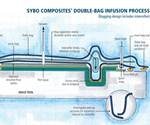Double-bag infusion: Thickness gradient and pressure
Cliff Walker (Vacmobiles, Auckland, New Zealand), explains how the large pressure changes during infusion result in laminate compression and thickness variations across the part.
Share
Cliff Walker (Vacmobiles, Auckland, New Zealand), explains how the large pressure changes which occur during infusion do result in laminate compression and thickness variations across the part: “Prior to resin flow, the absolute pressure inside the bag tends to be uniformly low (vacuum uniformly high). When resin starts to flow, the absolute pressure inside the bag at the resin feed rises toward atmospheric pressure (vacuum decrease toward zero), while the pressure remote from the resin feed (closest to the vacuum pump) remains low.” He goes on to say that without a double bag setup, the bag close to the resin feed will loosen and the laminate will increase in thickness, while the part of the bag near the vacuum pump will remain taut, compressing the laminate.
The Boeing Co.’s (Seattle, Wash.) patent for its Controlled Atmospheric Pressure Resin Infusion CAPRI double-bagging method notes, “Achieving a high fiber volume fraction requires compaction of the preform. Proper constraint of the preform against the forming surface during and after the infusion until the resin cures is critical.” It goes on to say: “If the net compaction pressure is insufficient (in traditional VARTM, it can approach zero) the preform is free to float in the resin or to spring back from its compacted state, leading to reduced fiber volume fractions.”
Walker counsels that bag loosening or swelling at the resin feed can be overcome without a double bag by reapplying vacuum to the resin feed region after the part has been filled with resin and resin supply has been stopped. Vacmobiles achieves this by adding another vacuum line to the same vacuum pump. However, the company reportedly has a new machine equipped with two vacuum pumps and two resin traps that can be run independently of each other.
Related Content
-
PEEK vs. PEKK vs. PAEK and continuous compression molding
Suppliers of thermoplastics and carbon fiber chime in regarding PEEK vs. PEKK, and now PAEK, as well as in-situ consolidation — the supply chain for thermoplastic tape composites continues to evolve.
-
Novel dry tape for liquid molded composites
MTorres seeks to enable next-gen aircraft and open new markets for composites with low-cost, high-permeability tapes and versatile, high-speed production lines.
-
Materials & Processes: Tooling for composites
Composite parts are formed in molds, also known as tools. Tools can be made from virtually any material. The material type, shape and complexity depend upon the part and length of production run. Here's a short summary of the issues involved in electing and making tools.











